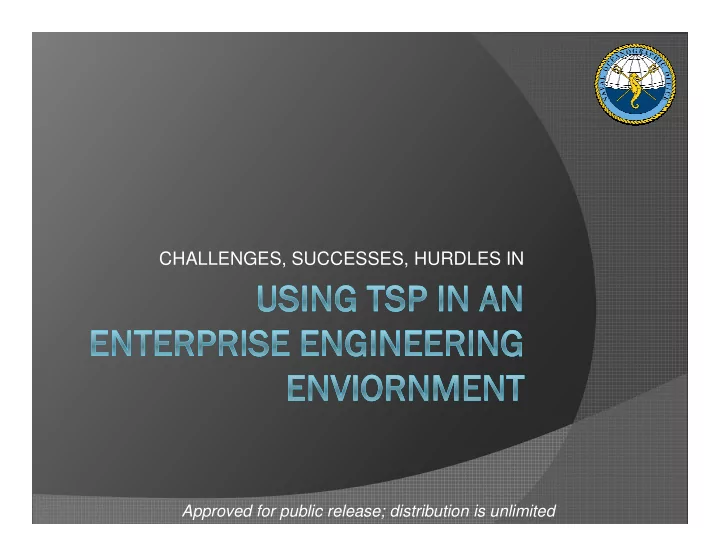

CHALLENGES, SUCCESSES, HURDLES IN Approved for public release; distribution is unlimited
�������������������� � 30 Thousand Foot View � Where did we come from � Our plan on become better… � How we succeeded! � How we succeeded! � How we failed! � What does it mean to be a success? � What now?!?
������������� Enterprise Change Requests (ECR) � Life Cycle Support (LCS) � GEO-CENTRIC KNOWLEDGE -CENTRIC Direct Tasking (DIR) � AOR based Aligned with Fleet Centralized IT procurement / budget � Focused on production Focused mission planning Requirements Validation and � of standard products and execution Endorsement Configuration Management � Information Assurance � Decision Superiority: Making better decisions faster than the adversary
����������������������� � Constant Change in Organization � Limited Understanding of Process � Customers Customer Customer � Stakeholders � Stakeholders Reality Demands � Between Teams � Autonomous teams � Firefighting mentality � Great at what we do
��� �� ��� �� �� �� �� �� ��� ��� ��� ������ ��
��������������������� � Manage Expectations � Accuracy vs. Consistency � Identify Areas for Improvement � Visibility into process � Visibility into process Analyze Data � Manage with Metrics Gather Data Black Box � Become “ fast-er ” Measures Current Process Limit Priority Capacity Visible Shifts Management
��������������������� � Functional Area Leadership (FAL) Team � Manage overall EED goals � Process hand-offs � Common Language � Common Language � Streamline Data collection � Answer specific questions � Clear, Achievable goals � Manage with Metrics � Determine what is a success
��� �� ��� �� �� �� ��� �� �� ��� ��� ��� ������ ��
���������� �����! � Setup team-of-teams � Establish the FAL � Key to inter-EED communications � Leadership of organization � Ownership of EED goals � Manage the overall process � Manage the overall process Collect USABLE Data � Speak Same language (TSP ss) � Other organizations (competitors) � don’t have data Manage Constraints � Comparing past to present � Shift resources for Emergencies �
����������" � Collected too much data � leaves open for interpretation � tedious � No more smoke and mirrors � Mistakes and shortcomings are out in open � Sub-Teams did not fully own process � Sub-Teams not collecting data in same way � TSP spreadsheets mainly used to track tasks after the fact � TSP spreadsheets, not all groups need that granularity � Sub-teams aren’t using data to make decisions � No clear means to plan tasks (what work gets done, what doesn’t) � Defect collection was limited; and not understood by teams
#��� �����$ ����� Metrics and making “smart” decisions with it � Document Process & everyone follows � Allows us to see problems…and a path to fix them… � Customers are aware of work being done (no longer black box) � Stakeholders leave us alone, “let us do our job” � Faster, Better, Cheap-”er” �
�������%� � Better Questions, get better answers � Collect data on what we need � Data mine data to determine process or quality issues quality issues � Readjust resources; no more fiefdoms � We are all one EED � Stakeholders trust… we know what we are doing
Recommend
More recommend